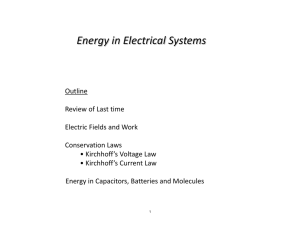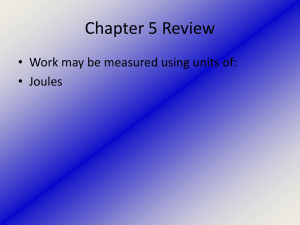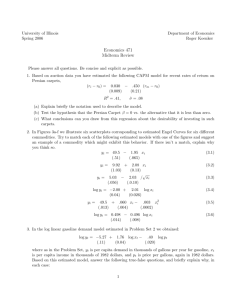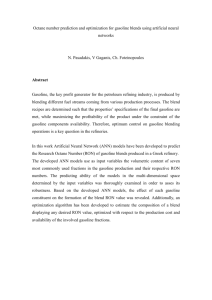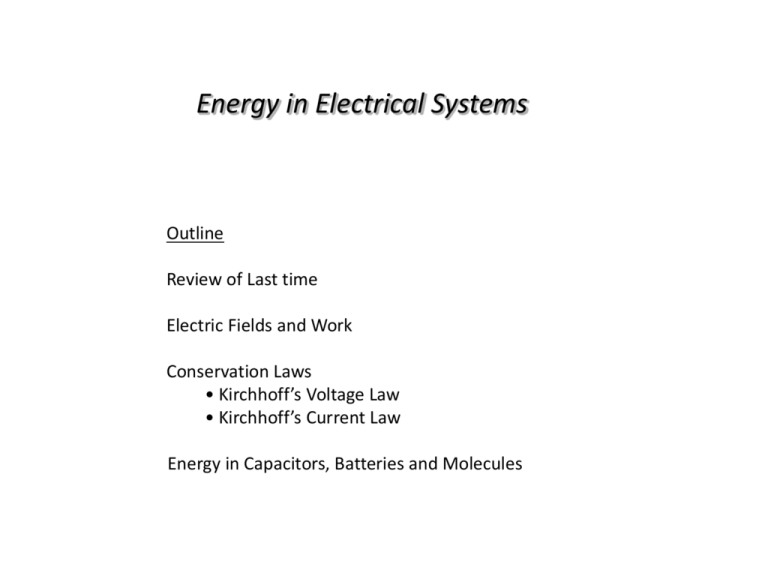
Energy in Electrical Systems
Outline
Review of Last time
Electric Fields and Work
Conservation Laws
• Kirchhoff’s Voltage Law
• Kirchhoff’s Current Law
Energy in Capacitors, Batteries and Molecules
TRUE or FALSE?
1. In steady state operation of a motor, all of the
energy that goes in is lost to heat due to friction.
2. In a motor, the back EMF is proportional to the
frequency of rotation.
3. Gauss’ Law states that
Today
we will consider
different methods of
Energy Storage in
Hybrid Vehicles
to solve the “mystery” of
why gasoline is so efficient
in storing energy
Capacitor
Image is in the public domain
Image is in the public domain
Battery
Prius NiMH: 1.8 kW-h
: 52 kg
Gasoline
1 gallon : 40 kW-h
: 2.75 kg
A REVIEW OF YESTERDAY’S LECTURE
When motor turns it generates “Back EMF”
• The 1st Law requires that any contraption that can be used as an
electromechanical actuator can use its actuation to generate EM fields:
- a motor can also be used as a generator.
- a loudspeaker can also be used as a microphone
• Torque of a motor = motor constant × motor current
• When frictional torque in a motor equals the morque from the Lorentz force
inside the motor, the net torque is zero and a steady operation is achieved.
Frictional Torque = constant × angular velocity
• Operated at CONSTANT CURRENT – motors have steady torque
• Operated at CONSTANT VOLTAGE – motors have steady angular velocity
• Energy stored in 1 gallons of gasoline is 35 kW-hr (or rounding-up 40 kW-hr)
• Electric vehicles are more economical per mile traveled, however, they can
travel fewer miles since the batteries store less energy per kg than fuel does
Hypothetical Gas-Powered Go-Cart:
Let’s make a comparison to a similar go-cart powered by a reasonably sized gasoline
engine and gas tank. Let’s replace the 36 pounds of batteries by a gas tank that holds
36 pounds of gasoline.
- Gasoline weighs 6 pounds per gallon,
- Gasoline stores 40,000 Watt-hours of heat energy per gallon. That is, if you
burned a gallon of gasoline, you would get 40,000 Watt-hours worth of heat.
How many joules are stored in a gallon
of gasoline?
144,000,000 J
How many gallons of gas are stored in the
hypothetical go-cart gas tank?
6 gallons
How many joules of heat energy are stored in
the go-cart gas tank?
864 MJ
In comparison, the battery stores
2.2
MJ
Main Question for Today
Why does gasoline have such a large energy density
Gasoline
1 gallon : 40 kW-h
: 2.75 kg
How does E&M help me?
Energy and Electric Fields
q
E
Can define electrostatic potential (potential energy of a positive test charge) …
Potential changes by
a certain amount (measured in Volts) over
certain distance (measured in meters)
For “conservative” fields like
in the electrostatic system,
the work
done by
does not depend on the path taken !
independent of path
Energy Conservation and Conversion
Consider the following circuit:
1
C
+
v1
-
2
path C
+
v2
-
+
- V
Ref = GND
For a closed loop (C), a=b so the energy expended in moving charge is zero…
Voltage drops around a closed loop (circuit) must sum to zero..
Kirchhoff’s Voltage Law (KVL)
Regenerative Brakes
Hybrid cars:
Energy from regenerative braking is
stored in banks of capacitors or the
battery.
1. Bicycling along
with kinetic energy
2. Brake going up
ramp. Kinetic energy
stored as potential
energy.
Image is in the public domain
3. Roll down ramp to
convert stored potential
energy back to kinetic
energy!
Example of KVL: Capacitor in Series with a Resistor
The stored energy in regenerative brakes of a hybrid-car (represented as capacitor)
can power a motor load (represented as resistor)
B C
D
E
F=A
POTENTIAL [V]
A
KVL is a statement of Conservation of Energy!
Kirchhoff’s Current Law (KCL)
Summed over
all currents
entering a node
KCL is a statement of Conservation of Mass !
Energy Stored in Capacitors
(we will assume that the structure is mechanically rigid)
i
C
+
v
-
How do we increase the energy storage?
εA
C=
d
Ultracapacitors
Traditional capacitor
Ultracapacitor
Ultracapacitor with
carbon nanotubes
Today’s Culture Moment
Phlogiston
The “element” that was heat
itself. This idea was
perpetuated by Georg Stahl
and was widespread in use by
scientists in the 1700s.
Phlogiston
Georg Stahl
“The remarkable thing about this amazing theory was that it
seemed to have worked, and it had been used by eminent and
respected early scientists for an entire century before it was
finally proven wrong….Phlogiston theory was perhaps the most
persistent, widespread, and totally wrong mistake made by
scientists all through the age when science, as we know it today,
was developed.”
Fawcett, 100 Mistakes that Changed History
© Penguin Group USA. All rights reserved. This content is excluded from our
Creative Commons license. For more information, see http://ocw.mit.edu/fairuse.
All images are in Public Domain
Atomic Capacitors
electron
cloud
Lets approximate the electron cloud as a spherical shell of charge (-q)
surrounding a positive nucleus (+q) …
… and try to estimate the capacitance, voltage, and energy …
Gauss’s Law
Flux of
through closed surface S = net charge inside V
Atomic Capacitor
Field from a point charge
Area integral gives a measure of the net charge
enclosed; Divergence of the electric field gives
the density of the sources.
(~ 1000 kW-hr per kg)
Atomic Capacitor
Stored energy for atomic hydrogen…
W ≈ ½ q v ≈ 14.4 eV ~ 1000 kW-hr/kg
Remember this unit of energy:
1 eV = 1.6 x 10-19 J
1.54 Å
1.16 Å
O
- -
- -
H H
H-C–C–H
H H
H
H
O=C=O
Energy [eV]
1.10 Å
ENERGY OF AN
ELECTRON IN AN
ALCANE
MOLECULE IN
GASOLINE
ENERGY OF AN
ELECTRON IN H2O
or CO2
0V
_
Hydrogen ground state energy is
-13.6 eV
If the hydrogen radius was twice
as long, what would be the
ground state energy ?
+
_
ENERGY GIVEN
OFF AS HEAT IN
THE PROCESS OF
GASOLINE
COMBUSTION
+
Remember this unit of energy:
1 eV = 1.6 x 10-19 J
Batteries
In 1780, Luigi Galvani discovered that when two different metals (copper and zinc for example)
were connected together and then both touched to different parts of a nerve of a frog leg at the
same time, they made the leg contract. He called this "animal electricity". The Voltaic pile invented
by Alessandro Volta in the 1800s is similar to the galvanic cell. These discoveries paved the way for
electrical batteries.
Capacity of Batteries:
AAA – 1250 mAh
AA – 2850 mAh
C – 8350 mAh
D – 20500 mAh
iPhone – 1400 mAh @3.7V
From Wikipedia article on the Galvanic cell
.
The more electrolyte and electrode material there is in the cell, the greater the capacity of the cell.
Thus a small cell has less capacity than a larger cell, given the same chemistry
(e.g. alkaline cells), though they develop the same open-circuit voltage.
Energy-to-Weight Ratio
FUELS
Hydrogen
Gasoline
79,000 W-hr/kg
13,000 W-hr/kg
ELECTROCHEMICAL CELLS
Nickel-Metal Hydride
Nickel-Iron
Lead-Acid
30~80 W-hr/kg
50 W-hr/kg
30 W-hr/kg
ATOMIC WEIGHTS:
H2 – 2 g/mol
O2 – 32 g/mol
S – 32 g/mol
C – 12 g/mol
Cu – 64 g/mol
Zn – 65 g/mol
Pb – 207 g/mol
DIFFERENCES ARE DUE TO THE RELATIVE MOLECULAR WEIGHTS
OF CONSTITUENT MATERIALS
AND A NEED FOR MECHANICAL STRUCTURE THAT SUPPORTS
THE ELECTROCHEMICAL CELLS
Today
we will consider
different methods of
Energy Storage in
Hybrid Vehicles
to solve the “mystery” of
why gasoline is so efficient
in storing energy
Capacitor
Image is in the public domain
Image is in the public domain
Battery
Prius NiMH: 1.8 kW-h
: 52 kg
Gasoline
1 gallon : 40 kW-h
: 2.75 kg
TRUE or FALSE?
1. In steady state operation of a motor, all of the
energy that goes in is lost to heat due to friction.
F
2. In a motor, the back EMF is proportional to the
frequency of rotation.
T
3. Gauss’ Law states that
F
Summary
Conservation Laws
Kirchhoff’s Voltage Law
Kirchhoff’s Current Law
Energy in capacitors, batteries, and gasoline:
Image by Tony Hisgett
http://www.flickr.com/photos/hisgett/5126927680/
on flickr
DIFFERENCES ARE DUE TO THE RELATIVE
MOLECULAR WEIGHTS OF CONSTITUENT MATERIALS
AND A NEED FOR MECHANICAL STRUCTURE THAT
SUPPORTS THE ELECTROCHEMICAL CELLS
Extra Example: Power from Stored Electrostatic Energy
Electrical power expended in moving charge from a to b…
For electrical quasistatic systems, EQS, (slowly varying E-fields)..
Exactly what you were expecting !
MIT OpenCourseWare
http://ocw.mit.edu
6.007 Electromagnetic Energy: From Motors to Lasers
Spring 2011
For information about citing these materials or our Terms of Use, visit: http://ocw.mit.edu/terms.

